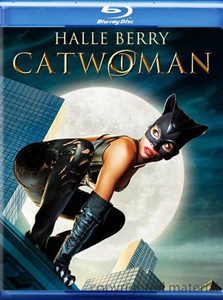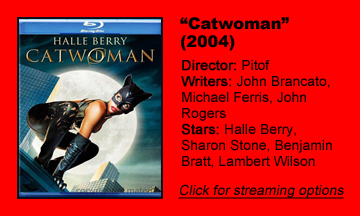Halle Berry won the Razzie for Worst Actress for “Catwoman” (2004) and famously accepted the award in person, but she is not at all the reason why this movie misses the mark. More into this role than she is her later turns as Storm in “X-Men,” Berry takes Patience Phillips through a blend of “She’s All That” and “Dr. Jekyll and Mr. Hyde” wherein she gains confidence but it takes her awhile to realize she’s two different people.
Misused CGI
The Razzie voters might’ve conflated Berry’s performance with the overall Catwoman performance, but Berry had no control over the character when in CGI form. The film makes the wild miscalculation of using an animated Catwoman every time she does martial arts or cat-like movements, especially if they are on rooftops.
It’s a crazy misfire, as even today human characters are not rendered in CGI except in rare circumstances in the most expensive movies. It’s like if segments from 2007’s animated “TMNT” were interspersed with the live-action “Turtles” films; we get two completely different styles, and inevitably it takes us out of the story.
“The Dark Knight Rises” (2012) and TV’s “Gotham” (2014-19) would perhaps learn from this misstep, as they feature Anne Hathaway’s naturally slinky movements and Camren Bicondova’s gymnastics and dance movement skills.
While “Catwoman” tries to be ahead of its time on CGI of human characters, it is behind its time by putting style ahead of substance.
This is the last of the five Burton/Schumacher “Batman” universe films, the previous of which was 1997’s “Batman & Robin.” Seven years later, moviegoers had moved past style-first superhero films, and indeed, the gritty “Batman Begins” (2005) – the start of the next iteration of the saga — was already in production at this point.
Dodging ‘Batman’ associations
Yet “Catwoman” doesn’t want to be associated with “Batman” (see also the 2002 “Birds of Prey” TV series for “Batman” stories that don’t want to admit they are “Batman” stories). This is the only iteration of the franchise that imaginations a whole history of catwomen – as chronicled in a decent opening montage of imagery and Ophelia’s (Frances Conroy) mid-film explanation – as opposed to a single Catwoman, a.k.a. Selina Kyle.
Michelle Pfeiffer’s Selina is seen among the pictures Ophelia shows to Patience. Further distancing this movie from “Batman,” it’s not set in Gotham City, but rather an unnamed big city.
Patience’s split-personality struggles are broadly endearing, though, and Berry has good chemistry with Benjamin Bratt’s police detective Tom Lone. The team of four writers illustrate this in odd ways, notably the infamous “sexy” basketball scene wherein Patience dunks on him while urged on by playground kids.
“Catwoman” often gives the sense of a film crafted by people who don’t understand modern American language and behavior, another example being when the gay guy next to Patience’s cubicle calls Lone a “man sandwich.”

Director Pitof gets a lot of blame for this movie’s failures (probably because his single name makes him seem pretentious), but the screenplay is worse, featuring corny one-liners, telegraphed beats and a general misunderstanding of office interactions. While Pitof certainly puts style over substance, the film’s style isn’t terrible.
Decent design
In fact, the set designers do great work. Patience’s office looks like an exciting and modern place to work as she designs packaging for the facial cream Beau-line. A later sequence takes place at an opera, culminating in one of those behind-the-curtain catwalk fights that “Mission: Impossible” and “James Bond” later embraced.
Sharon Stone’s Laurel Hedare emerges as a villain who has (probably accidental) echoes of Clayface. While the Beau-line cream ravages and kills women who get addicted to it and then stop using it, it turns consistent users’ skin into marble, and that’s Hedare’s superpower when facing Catwoman.
The commentary about society’s obsession with women’s beauty only runs skin deep, but it is consistently present, and includes a pointed line from Hedare when she notes that she had all the power in the world until she turned 40 – a well-known curse for Hollywood actresses. (Stone is one example, having not been in many major roles since “Catwoman.”)
“Catwoman” is not a good movie, and it is entertaining to listen to podcasts making fun of it, but it’s only a couple miscalculations away from being decent. Because it was released after its ideal window and because of its hesitance to connect with “Batman,” it’s treated as worse than it really is.
I don’t want to watch it again, but if I were given a choice of torture techniques, I’d pick “Catwoman” as a less painful option than both “Swamp Things,” “Steel,” “The Green Hornet” and even “Batman Forever.”


